

You are using an out of date browser. It may not display this or other websites correctly.
You should upgrade or use an alternative browser.
You should upgrade or use an alternative browser.
dbltree
Super Moderator
June 12th, 2011
I clipped some winter rye and red clover stands about 10 days ago....
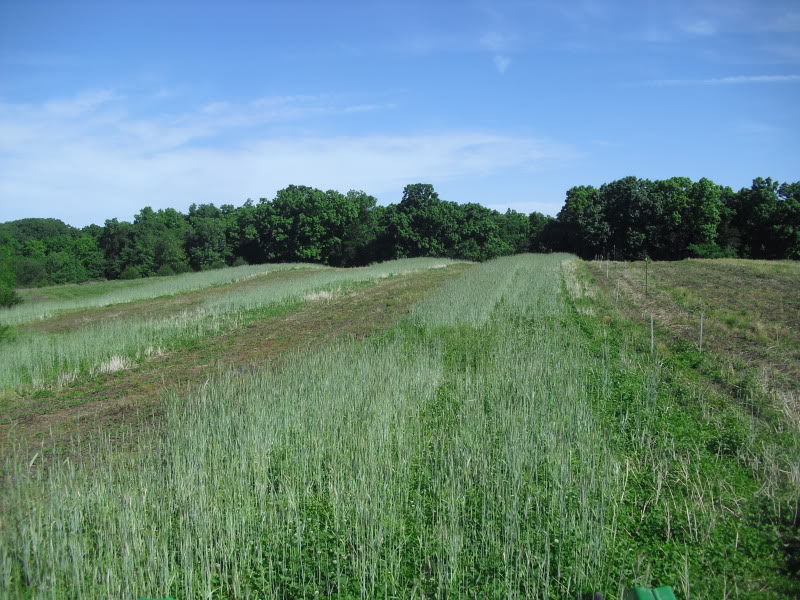
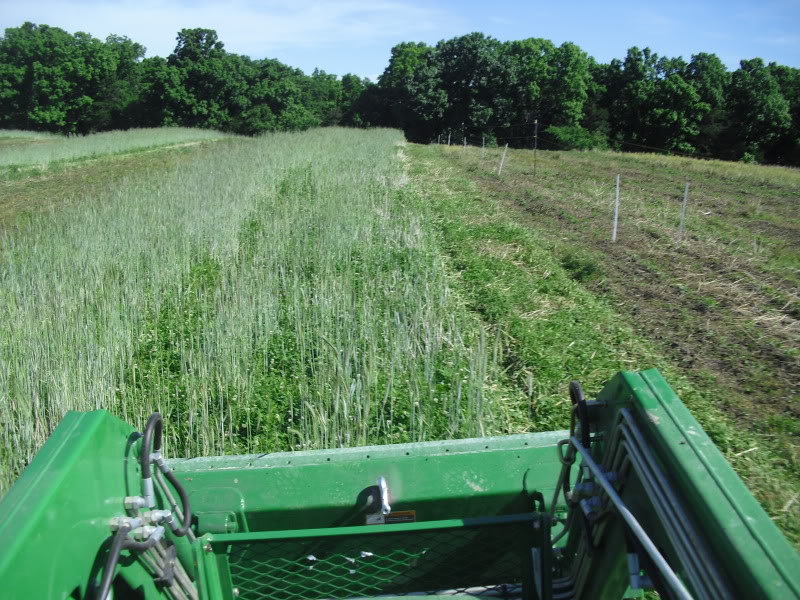
You can see the rye is easily clipped off at this stage and will not attempt to re-grow
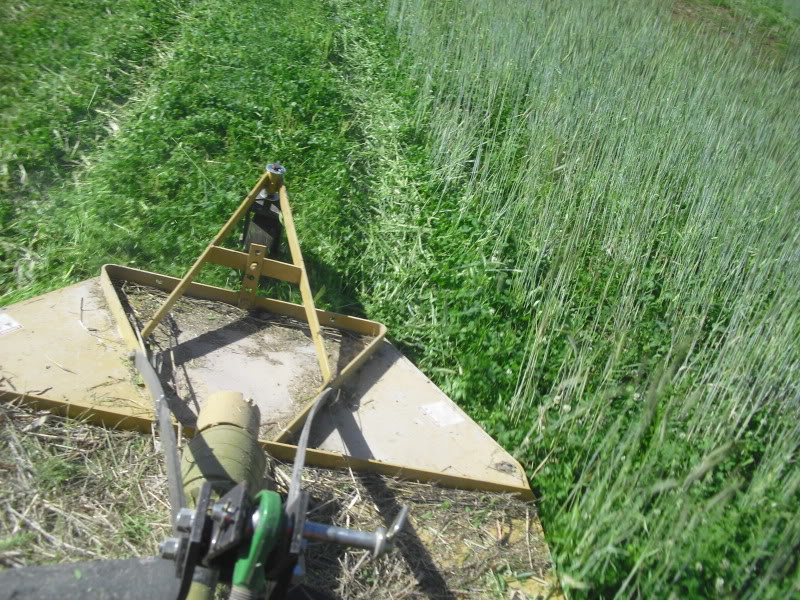
The only drawback to late May/early June mowing is that does tend to hide fawns in it and you run the risk of killing a fawn at that time. So the other option is of course to just leave it standing....

In this case the white and red clovers are lush and healthy growing well under the winter rye that towers above
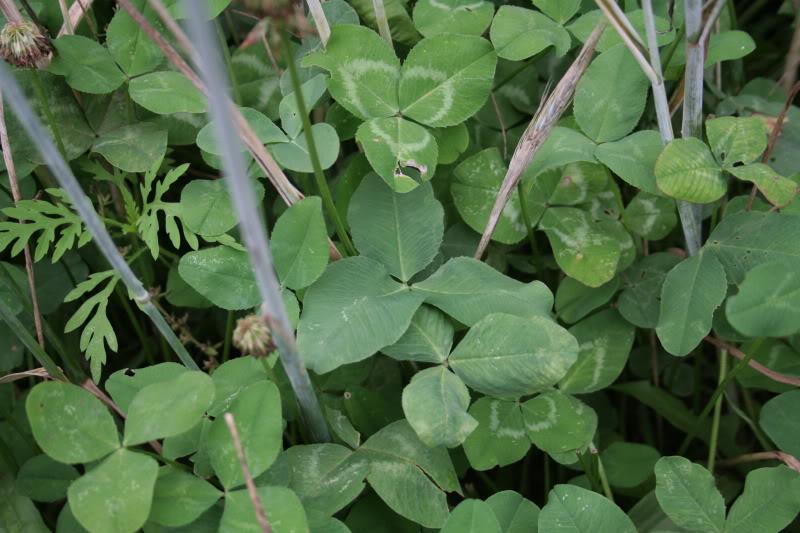
In this strip plot I clipped the rye/clover strip in the foreground but the clover does not look one bit better then where the rye is standing


This strip of rye and clover will be left standing for now

and clipped later to promote clover growth and continued N fixation
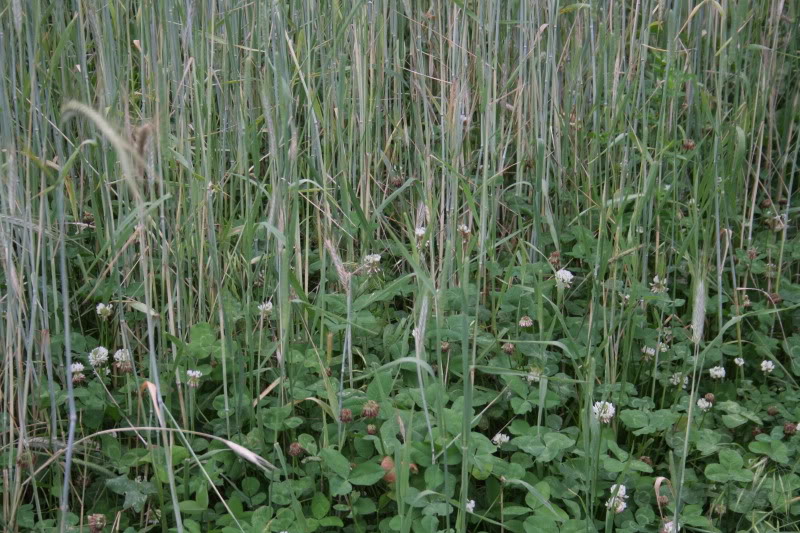
then tilled under for brassicas in July

The winter rye/oats/peas/radish/red clover combination is perfect for those who cannot make multiple trips to their property each year. It can be planted in late August to early September and then if need be...not touched again until it's turned under to repeat the process the following fall.
In my case I use it with a brassica rotation but even then as you can see clipping is optional and if weather or work get in that way...no worries...it will be providing great cover and high quality food sources all summer long.... :way:
I clipped some winter rye and red clover stands about 10 days ago....


You can see the rye is easily clipped off at this stage and will not attempt to re-grow

The only drawback to late May/early June mowing is that does tend to hide fawns in it and you run the risk of killing a fawn at that time. So the other option is of course to just leave it standing....

In this case the white and red clovers are lush and healthy growing well under the winter rye that towers above

In this strip plot I clipped the rye/clover strip in the foreground but the clover does not look one bit better then where the rye is standing


This strip of rye and clover will be left standing for now

and clipped later to promote clover growth and continued N fixation

then tilled under for brassicas in July

The winter rye/oats/peas/radish/red clover combination is perfect for those who cannot make multiple trips to their property each year. It can be planted in late August to early September and then if need be...not touched again until it's turned under to repeat the process the following fall.
In my case I use it with a brassica rotation but even then as you can see clipping is optional and if weather or work get in that way...no worries...it will be providing great cover and high quality food sources all summer long.... :way:
dbltree
Super Moderator
June 22nd, 2011
Our fall cereal plantings are months away but just a reminder to remember to add clover to your fall planting. If you are wise and intend to rotate the planting to another crop such as brassicas, either an inexpensive white clover or a mammoth red clover will work for all those except extremely dry sandy soils or those in the drought stricken parts of the south.
If you plan to follow the winter rye with an early spring crop such as corn or sugar beets, then annual crimson clover might be best. Crimson grows extremely fast in the spring...perfect for a mid spring plow down. If however you intend to follow the rye with a mid summer brassica planting or even a repeat of the rye combination....then white or red clover is a better option. Crimson grows fast, matures, goes to seed and then is generally kaput, while the mammoth red clover will continue to grow, providing lush high quality summer feed , fixing nitrogen and tons of biomass!
Here's an example of mixed white and red clovers after I clipped the rye off a few weeks back...beautiful!
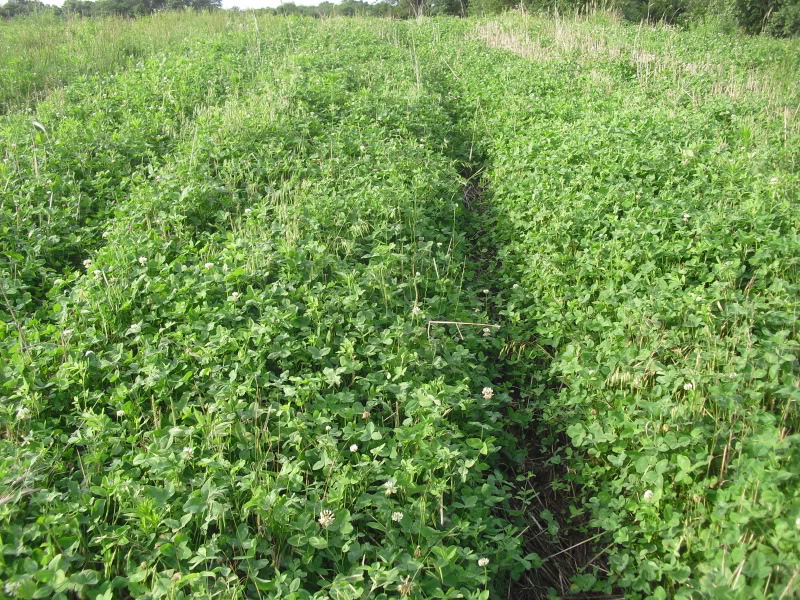
The clovers are growing like mad and deer are wading knee deep in it! Note the rye stubble and straw now barely visible through the thick clovers.
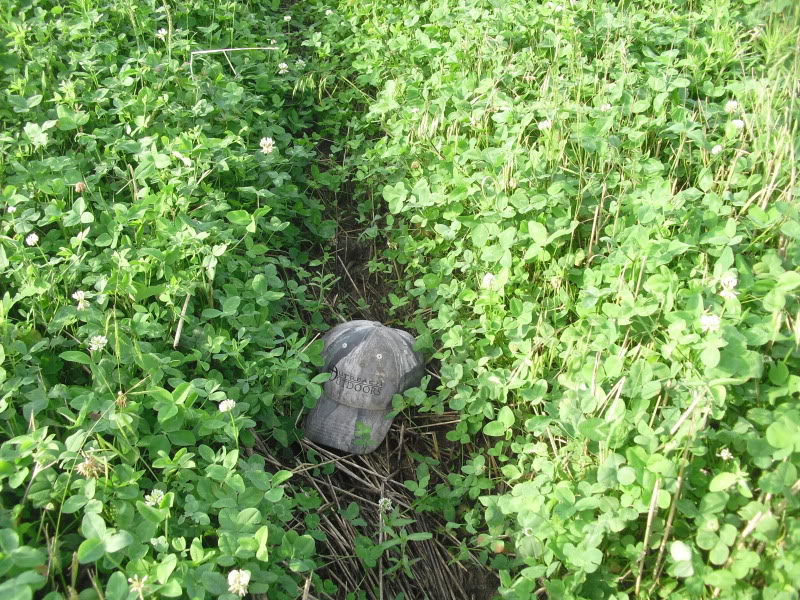
These clovers will be tilled under for brassicas in mid July and adding all of that biomass to the soil will improve it immensely! The killed legumes will slowly release nitrogen as they decompose, providing at least a portion of the nitrogen the brassicas hunger for.
Add clovers to your fall cereal planting and you'll be insured of holding deer not only fall and winter, but spring and summer as well... :way:
Our fall cereal plantings are months away but just a reminder to remember to add clover to your fall planting. If you are wise and intend to rotate the planting to another crop such as brassicas, either an inexpensive white clover or a mammoth red clover will work for all those except extremely dry sandy soils or those in the drought stricken parts of the south.
If you plan to follow the winter rye with an early spring crop such as corn or sugar beets, then annual crimson clover might be best. Crimson grows extremely fast in the spring...perfect for a mid spring plow down. If however you intend to follow the rye with a mid summer brassica planting or even a repeat of the rye combination....then white or red clover is a better option. Crimson grows fast, matures, goes to seed and then is generally kaput, while the mammoth red clover will continue to grow, providing lush high quality summer feed , fixing nitrogen and tons of biomass!
Here's an example of mixed white and red clovers after I clipped the rye off a few weeks back...beautiful!

The clovers are growing like mad and deer are wading knee deep in it! Note the rye stubble and straw now barely visible through the thick clovers.

These clovers will be tilled under for brassicas in mid July and adding all of that biomass to the soil will improve it immensely! The killed legumes will slowly release nitrogen as they decompose, providing at least a portion of the nitrogen the brassicas hunger for.
Add clovers to your fall cereal planting and you'll be insured of holding deer not only fall and winter, but spring and summer as well... :way:
whitetail fanatic
Member
Paul, does crimson clover survive the winter in southern Wisconsin if I plant it in the fall? If so, I might add that to my rye/radish planting, which would be plowed under the following May to plant corn. Assuming the crimson clover would survive our winters, would it be taller/thicker by early May than something like the Mammoth red clover? I guess I always thought crimson would not survive our winters since it was an 'annual' clover, but by your last post, it sounds like it would survive the winter. Berseem clover, of course, would not survive freezing temps would it?
thanks!
thanks!
Last edited:
Paul, does crimson clover survive the winter in southern Wisconsin if I plant it in the fall? If so, I might add that to my rye/radish planting, which would be plowed under the following May to plant corn. Assuming the crimson clover would survive our winters, would it be taller/thicker by early May than something like the Mammoth red clover? I guess I always thought crimson would not survive our winters since it was an 'annual' clover, but by your last post, it sounds like it would survive the winter. Berseem clover, of course, would not survive freezing temps would it?
thanks!
I'll let Dbltree fire back on that one BUT... I bought a new farm that had Crimson planted last year... About 1 month ago it was full flowers and looked like great healthy clover- even though it's an annual- made it from last year through our really cold winters here in IA and was going strong this spring. I'm doing something else with the area now BUT it looked really nice as of a month ago.
dbltree
Super Moderator
Paul, does crimson clover survive the winter in southern Wisconsin if I plant it in the fall? If so, I might add that to my rye/radish planting, which would be plowed under the following May to plant corn. Assuming the crimson clover would survive our winters, would it be taller/thicker by early May than something like the Mammoth red clover? I guess I always thought crimson would not survive our winters since it was an 'annual' clover, but by your last post, it sounds like it would survive the winter. Berseem clover, of course, would not survive freezing temps would it?
thanks!
I believe several people from WI are having success with crimson surviving the winter when fall planted. I would give it a try Wes....
KSQ2
PMA Member
Dbltree, does Welters sell red clover in bulk, or just 50 lb. bags? Which red would you recommend for fall planting with rye? I'll be tilling it next late summer for brassica planting. And I'll only be planting about a 1/3 acre. Does the red fix more nitrogen then Alice? If not, what's the advantage of red over white?
Last edited:
dbltree
Super Moderator
Dbltree, does Welters sell red clover in bulk, or just 50 lb. bags? Which red would you recommend for fall planting with rye? I'll be tilling it next late summer for brassica planting. And I'll only be planting about a 1/3 acre. Does the red fix more nitrogen then Alice? If not, what's the advantage of red over white?
Welters sells all of their clover, alfalfa, brassica and other such small seed by the pound even if it isn't listed that way.
I use Alta-Swede mammoth red clover Alta-Swede Red clover
It's inexpensive and perfect for a plow down clover the following year and deer really hammer the stuff.
It's not better then white,, white can fix more N per acre but white clovers generally are a little more expensive so i usually add white clover when I want that plot or strip to be in perennial clover. Either white or red will work great to add with rye in the fall, both will feed deer and provide a source of nitrogen when killed and turned under the following year.
No right or wrong....just add the clover of your choice with your fall cereal grains...you'll be glad you did....:way:
When mixing red and white clovers, how many pounds of each do you use per acre? From my understanding, one should plant clover at around 6-8# per acre. Therefore, do you go heavier on the white than reds when mixing the two together?
For example
5# of alice or other white clover
3# of mammoth red?
For example
5# of alice or other white clover
3# of mammoth red?
dbltree
Super Moderator
When mixing red and white clovers, how many pounds of each do you use per acre? From my understanding, one should plant clover at around 6-8# per acre. Therefore, do you go heavier on the white than reds when mixing the two together?
For example
5# of alice or other white clover
3# of mammoth red?
If the intent is to leave it in white clover for 3-4 years then I plant 5-6#'s of white and 5-6#'s of mammoth red clover. The red will not last more then a year at best unless you plant the more expensive red clovers that will last 2-3 years.
I usually don't mix them much anymore....red for plow down, white for perennial clover plot but mixing them up won't hurt a thing either...
dbltree
Super Moderator
It's almost time to till under the red clover we planted last fall with winter rye to plant brassicas as part of our ongoing crop rotations. Farmers across the country have been taking advantage of the benefits of adding red clovers to cereal grain crops like wheat and triticale harvested for grain, for some time now. They often fly red clover seed into standing soybeans or frost seed it into winter cereals but for whitetails we can add it at planting time in late August.
Now...by early July the red clover is nearly knee high and keeping our deer happy!

So what now? How best to take advantage of the tons of biomass and 100+ pounds of nitrogen that red clover can add to our soils? There are options for everyone regardless of equipment or lack of it with some providing slightly more benefits then others.
Farming crop systems are slightly different then ours of course because crops are harvested, combined, baled or grazed so agricultural links on this subject have great information, all of which however is not applicable to food plot/whitetail management situations.
The quote below holds some valuable information and comes from this ISU publication:
Cereal Grains and red Clover
Two key elements to consider here are that tiling the red clover under will in the end provide more nitrogen for your brassicas then chemically killing it and no-tilling into it. Looking at the time frame in which nitrogen is released from the rapidly decomposing clover we see that it is perfect for short season brassicas! If we plant 60-90 season brassicas the 10 week time frame is ideal to help provide at least a portion of the nitrogen our brassicas will require.
By this time the rye will be starting to mature and dry down (turn brown) if it was left standing and regardless if mowed or plowed under the decomposing root systems will also release scavenged nutrients for the following crop.

Rye and red clover
Lacking a plot many small plotters will find that they will need to mow the clover and rye to chop/shred it to a manageable height and then you have the option of no-tilling brassica seed into the stand and killing the clover with 2 quarts of glyphosate or discing/tilling it under to conventionally plant your brassica seed.
It is not necessary to completely turn under all of the clover/rye to have a successful brassica planting, doing so however does increase the available N as we see in the above quote. The ability of the soil to hold nitrogen is of course another factor in all of this so increasing the organic matter is extremely important and work towards that end every time we incorporate crops like clover and rye back into the soil.
Higher OM content also increases the ability of the soil to hold water and nutrients , versus very sandy soils for instance that allow rapid leaching of both water and nutrients. That being said, each of us has different soils so the need for additional nitrogen will vary widely...those with deep, rich black loam soils will probably get by with less then those with coarse sandy soils for instance.
Those of you who can see the value in planting multiple crops within each field and then rotating those crops yearly will want to experiment with additional nitrogen applications. I prefer to till in urea at planting rather then take a chance on catching a rain to incorporate it later so you may try marking off areas and applying urea at different rates to check the brassica response. What you learn may yield answers for future plantings on that soil type. If the ares you apply lower rares appear to suffer compared to the higher rates you can always broadcast additional urea on later (just time it within 24 hours of a good rain!)
If you are following white or red clover with brassicas this year...try varying rates of added nitrogen and then share the results so that others can learn as well.... :way:
Now...by early July the red clover is nearly knee high and keeping our deer happy!

So what now? How best to take advantage of the tons of biomass and 100+ pounds of nitrogen that red clover can add to our soils? There are options for everyone regardless of equipment or lack of it with some providing slightly more benefits then others.
Farming crop systems are slightly different then ours of course because crops are harvested, combined, baled or grazed so agricultural links on this subject have great information, all of which however is not applicable to food plot/whitetail management situations.
The quote below holds some valuable information and comes from this ISU publication:
Cereal Grains and red Clover
There are many options for managing red clover as a
green manure crop, including tillage and chemical control
in both fall and spring.
Plowing red clover provides about
two times more nitrogen to a subsequent corn crop as
chemical control.
Zone tillage of clay loam soil following
red clover has produced corn yields similar to conventional
tillage. The high nitrogen content of red clover residue
accelerates the decomposition of cereal crop residue.
There are several advantages associated with autumn
chemical kill of red clover before planting no-tillage corn,
including earlier planting dates, warmer soil conditions,
reduced risk of dry seedbed conditions, and reduced
likelihood of clover competition with early corn growth.
Red clover residues decompose rapidly after spring kill
with half of the nitrogen released within 4 weeks after
burial and very little nitrogen released after 10 weeks.
When red clover is killed before planting, nitrogen is
released from residue in synchrony with the nitrogen
uptake pattern of corn.
Delaying kill of red clover from
fall until spring does not increase nitrogen availability.
Killing red clover in the fall or early spring can be effective
for limiting soil water loss without sacrificing benefits to a
subsequent crop.
Two key elements to consider here are that tiling the red clover under will in the end provide more nitrogen for your brassicas then chemically killing it and no-tilling into it. Looking at the time frame in which nitrogen is released from the rapidly decomposing clover we see that it is perfect for short season brassicas! If we plant 60-90 season brassicas the 10 week time frame is ideal to help provide at least a portion of the nitrogen our brassicas will require.
By this time the rye will be starting to mature and dry down (turn brown) if it was left standing and regardless if mowed or plowed under the decomposing root systems will also release scavenged nutrients for the following crop.

Rye and red clover
Lacking a plot many small plotters will find that they will need to mow the clover and rye to chop/shred it to a manageable height and then you have the option of no-tilling brassica seed into the stand and killing the clover with 2 quarts of glyphosate or discing/tilling it under to conventionally plant your brassica seed.
It is not necessary to completely turn under all of the clover/rye to have a successful brassica planting, doing so however does increase the available N as we see in the above quote. The ability of the soil to hold nitrogen is of course another factor in all of this so increasing the organic matter is extremely important and work towards that end every time we incorporate crops like clover and rye back into the soil.
Higher OM content also increases the ability of the soil to hold water and nutrients , versus very sandy soils for instance that allow rapid leaching of both water and nutrients. That being said, each of us has different soils so the need for additional nitrogen will vary widely...those with deep, rich black loam soils will probably get by with less then those with coarse sandy soils for instance.
Those of you who can see the value in planting multiple crops within each field and then rotating those crops yearly will want to experiment with additional nitrogen applications. I prefer to till in urea at planting rather then take a chance on catching a rain to incorporate it later so you may try marking off areas and applying urea at different rates to check the brassica response. What you learn may yield answers for future plantings on that soil type. If the ares you apply lower rares appear to suffer compared to the higher rates you can always broadcast additional urea on later (just time it within 24 hours of a good rain!)
If you are following white or red clover with brassicas this year...try varying rates of added nitrogen and then share the results so that others can learn as well.... :way:
dbltree
Super Moderator
July 7th,2011
Here is a field that was in rye and crimson clover last fall and mowed in early June...nothing but weeds now
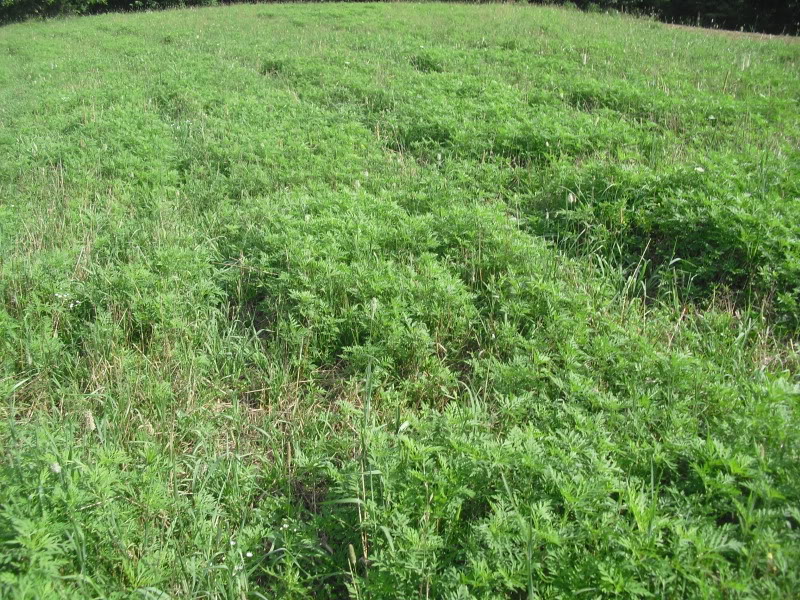
The crimson being an annual died out when it went to seed and there is nothing there to prevent weeds from returning
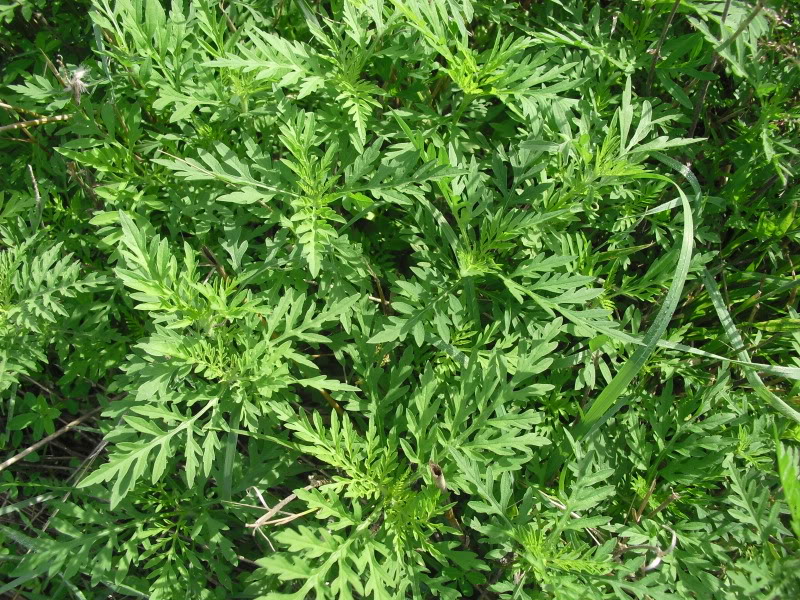
Compared to those places where re and/or white clovers were planted with the rye in the fall

While even a good crop of weeds can add organic matter to the soil when tilled under, it pales in comparison to tilling under 2 1/2 tons of biomass from red clover and 130#'s of nitrogen as the legumes decompose nor are deer interested in feeding vigorously on the weed.
Use oats and crimson or berseem in the spring to follow brassicas or crimson in the fall if you plan to till it under in early spring, otherwise add perennial clovers to you fall mix to insure you'll have an attractive summer long food source...minus the weeds! :way:
Here is a field that was in rye and crimson clover last fall and mowed in early June...nothing but weeds now

The crimson being an annual died out when it went to seed and there is nothing there to prevent weeds from returning

Compared to those places where re and/or white clovers were planted with the rye in the fall

While even a good crop of weeds can add organic matter to the soil when tilled under, it pales in comparison to tilling under 2 1/2 tons of biomass from red clover and 130#'s of nitrogen as the legumes decompose nor are deer interested in feeding vigorously on the weed.
Use oats and crimson or berseem in the spring to follow brassicas or crimson in the fall if you plan to till it under in early spring, otherwise add perennial clovers to you fall mix to insure you'll have an attractive summer long food source...minus the weeds! :way:
dbltree
Super Moderator
July 10th, 2011
By golly you sure can grow some awesome clover by planting it in the fall with winter rye!
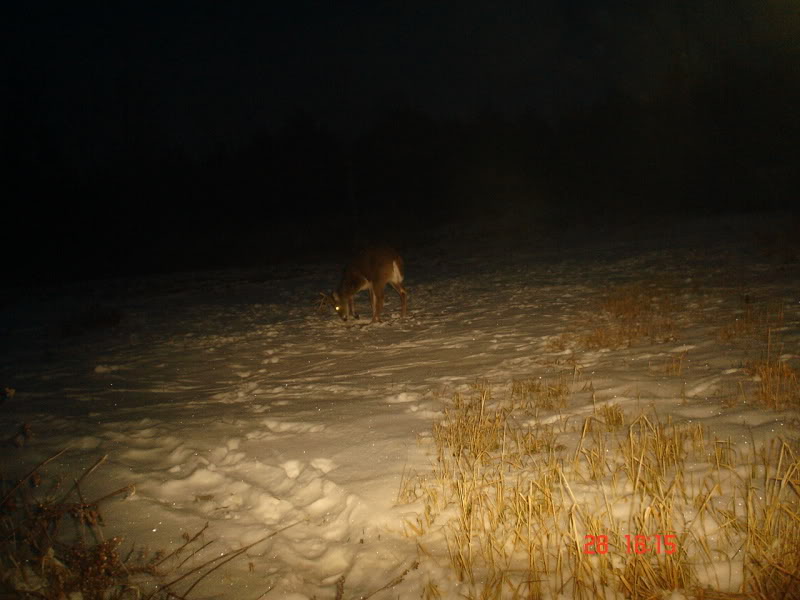
Red clover
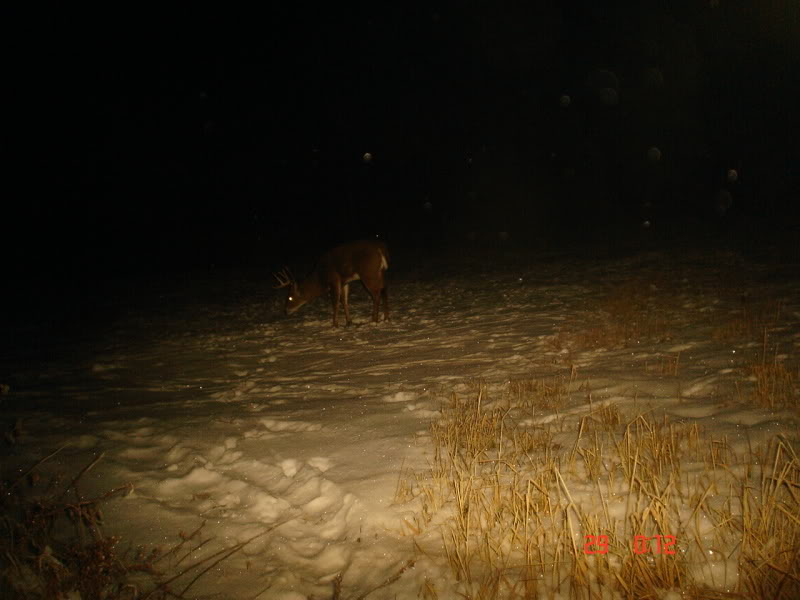
White clover
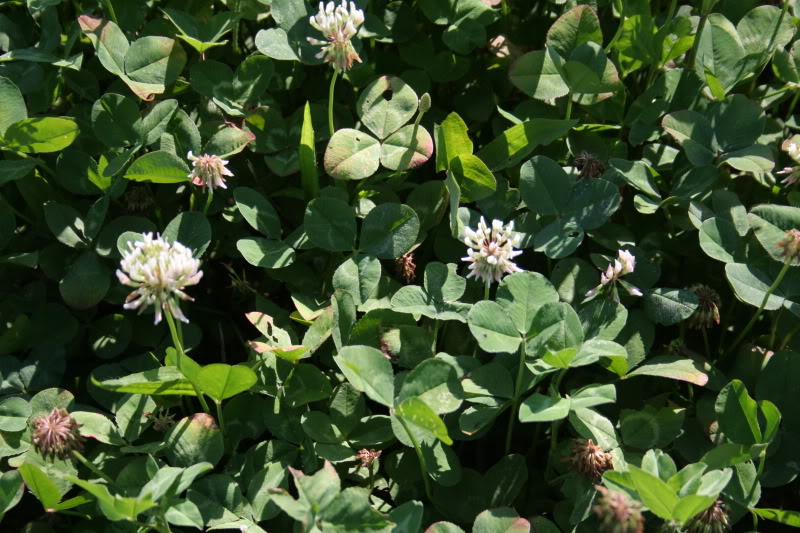
Tall and thick!
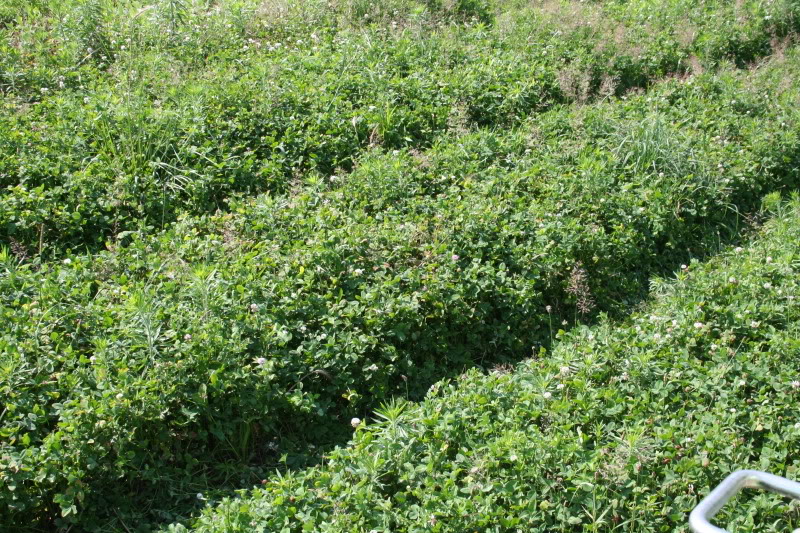
Just right to turn under for brassicas!
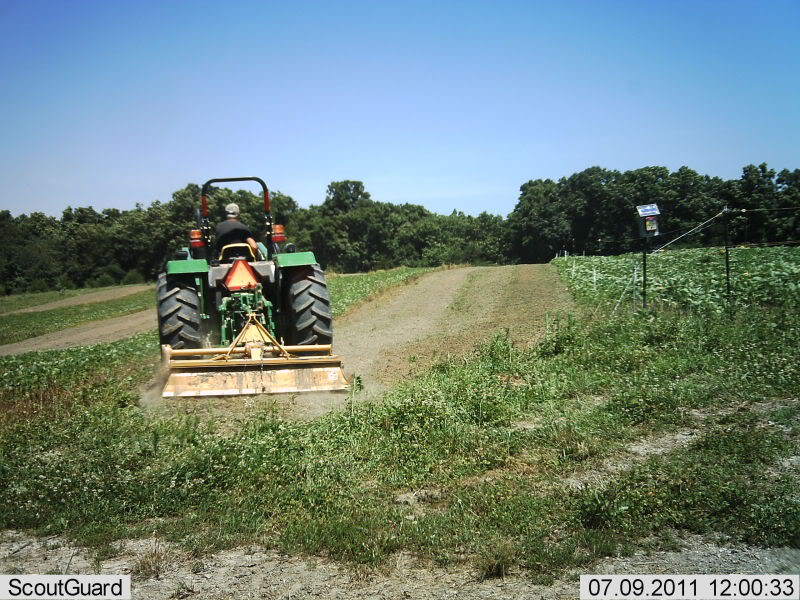
The rye/oats/peas/radish components kept deer fat and happy all fall, winter and into spring
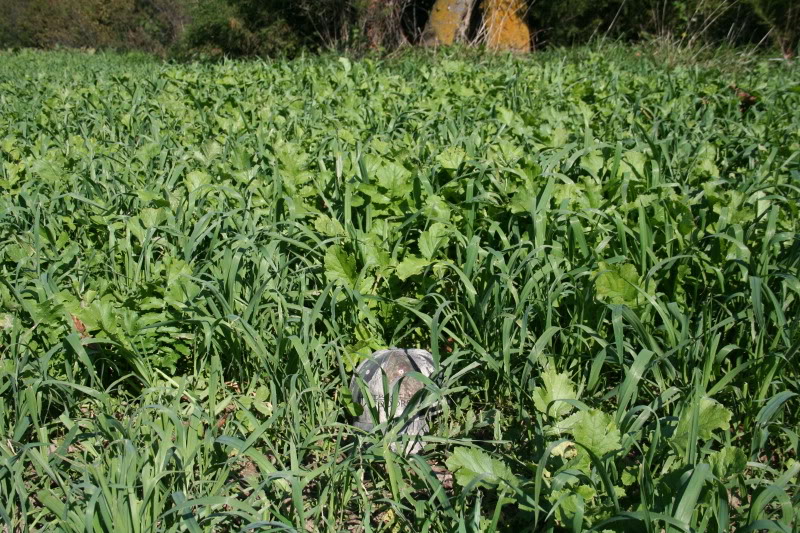
and then the clovers took over and kept them coming all spring and summer
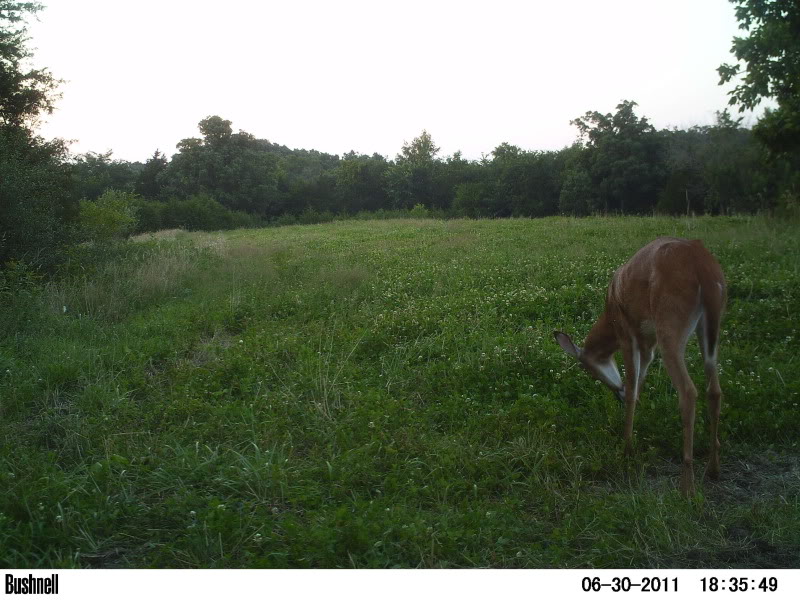
Now it's come full circle and will feed the upcoming brassica crop and help build the soil with tons of awesome organic matter and nitrogen that the brassicas will use the rest of the summer.
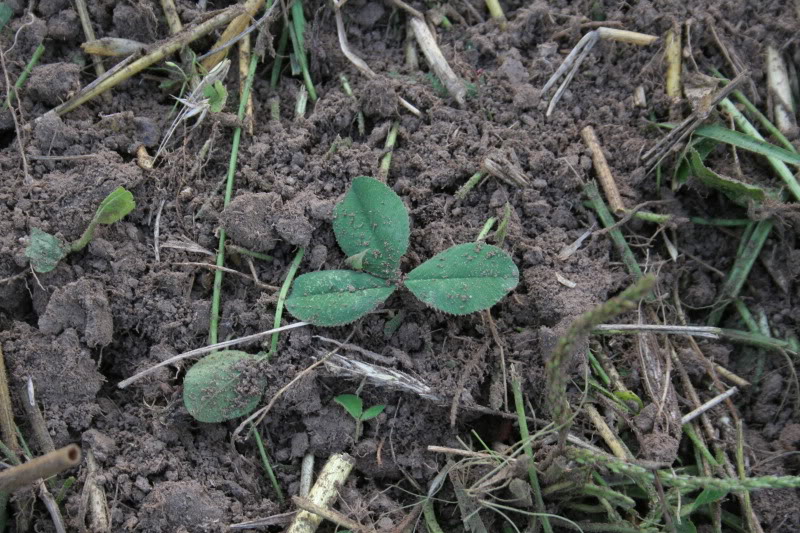
Despite tilling under this clover, deer will still never be without feed...in this field they have soybeans and perennial white clovers to keep them coming (in the unfenced area)
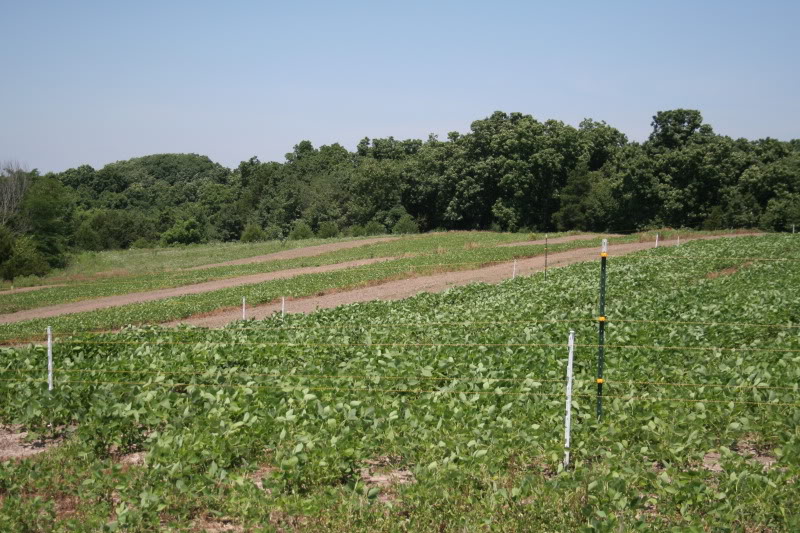
Plant multiple crop types within each plot and remember to add red clover, white clover or a combination of the two this fall with your rye, oat, pea, radish planting and you be able to keep deer coming to your plot year around....not to mention cutting your fertilizer and herbicide bills... :way:
By golly you sure can grow some awesome clover by planting it in the fall with winter rye!

Red clover

White clover

Tall and thick!

Just right to turn under for brassicas!

The rye/oats/peas/radish components kept deer fat and happy all fall, winter and into spring

and then the clovers took over and kept them coming all spring and summer

Now it's come full circle and will feed the upcoming brassica crop and help build the soil with tons of awesome organic matter and nitrogen that the brassicas will use the rest of the summer.

Despite tilling under this clover, deer will still never be without feed...in this field they have soybeans and perennial white clovers to keep them coming (in the unfenced area)

Plant multiple crop types within each plot and remember to add red clover, white clover or a combination of the two this fall with your rye, oat, pea, radish planting and you be able to keep deer coming to your plot year around....not to mention cutting your fertilizer and herbicide bills... :way:
dbltree
Super Moderator
will clover get enough growth to help if i frost seed into corn and beans and then till to plant corn and beans in spring again. I planted corn and beans into a clover/alfalfa plot this year and it is doing great and i added no fertilizer. Some corn is already producing ears.
Usually it takes nearly 6 months to get enough plant/root development to get substantial N fixation so frost seeding would mean you only have seedlings by spring.
A better option is to leave a portion of the field in clover each year, then rotate corn to the clover and establish new clover with rye each fall. You can also get away with light discing of established clover and planting corn into it. Often the clover will not die and will creep back and you can repeat the process the following year.
This option again works best if you can leave a portion standing in clover and rotate corn in and out of it allowing a portion of the clover to recover each year. :way:
SoDakarcher
Member
Db/tree,
I have noticed that you use a rotary tiller a great deal. Do you have any experiences with the different makes for cat2 type tractors(40-90hp)? Do you have a favorite make or size? What depth do you typically use for dead sod going to food plots, or turning under last years clover?
Thanks for your time. Bryan
I have noticed that you use a rotary tiller a great deal. Do you have any experiences with the different makes for cat2 type tractors(40-90hp)? Do you have a favorite make or size? What depth do you typically use for dead sod going to food plots, or turning under last years clover?
Thanks for your time. Bryan
dbltree
Super Moderator
Db/tree,
I have noticed that you use a rotary tiller a great deal. Do you have any experiences with the different makes for cat2 type tractors(40-90hp)? Do you have a favorite make or size? What depth do you typically use for dead sod going to food plots, or turning under last years clover?
Thanks for your time. Bryan
Here's a series of threads that might answer a few question about tillers and a lot of other equipment for that matter.
Equipment for food plots
The depth is probably around 4" roughly but I haven't actually measured to see? The King Kutter and Frontier models both bury 12-18" high clover or killed sod very well...:way:
dbltree
Super Moderator
Leaving winter rye standing for the summer with clover growing beneath it certainly doesn't impede deer from grazing the clover!
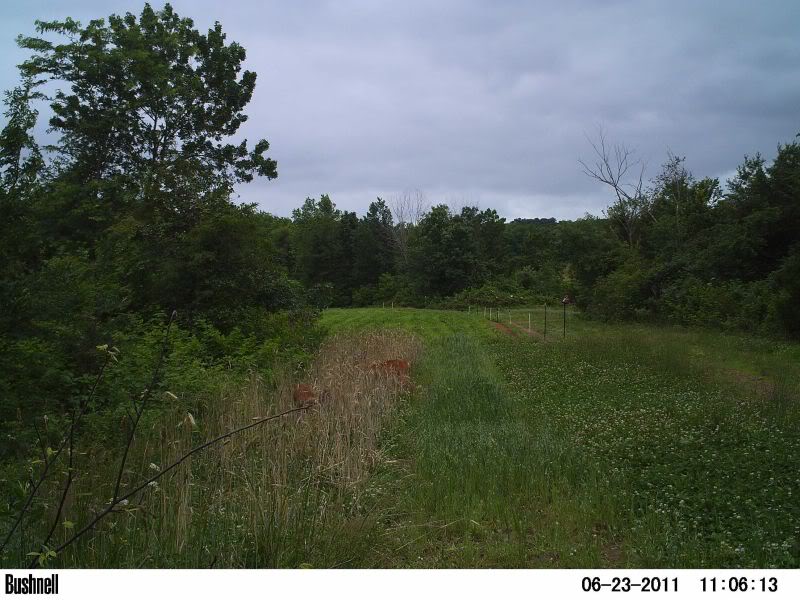
There is plenty of clover only steps away yet these deer readily dive into the standing rye for the lush clover growing there!
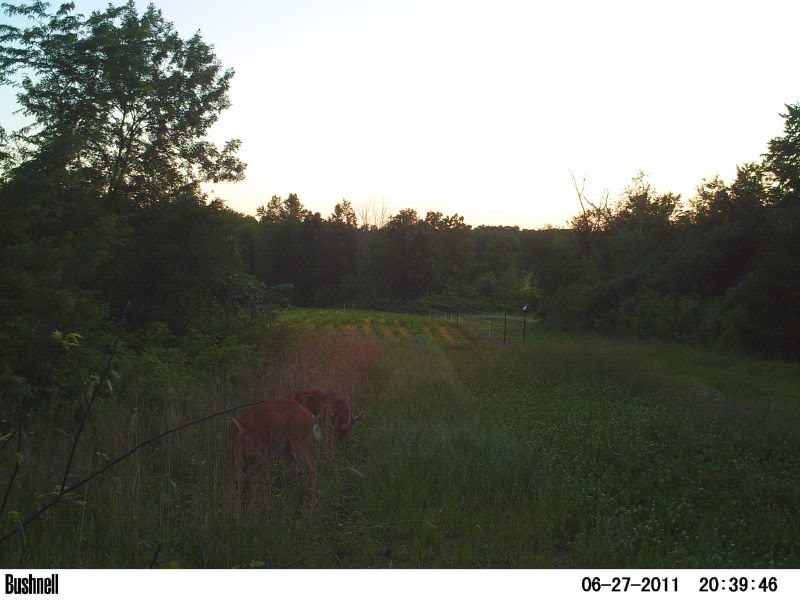
The oats and berseem planted where brassicas had been are maturing now
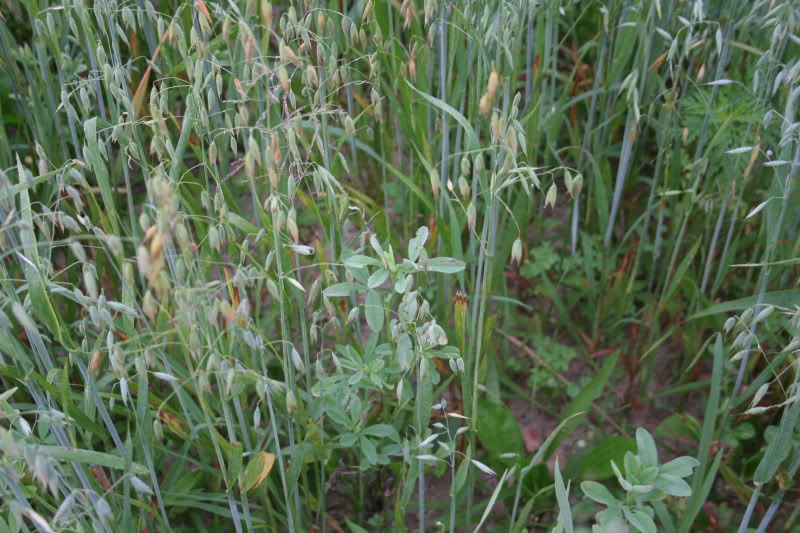
Instead of leaving a dead barren spot where the dead brassicas had been, I use oats and annual clovers to provide more high quality food sources and build up the soils with a great cover crop. Th chickling vetch added to the mix is a legume like clover and fits in well to add more nitrogen to the soil when I till it under.

The neat thing about this mix is that I will also have free oats when I till it under for the winter rye/oat/forage pea/forage radish/clover mix this fall!
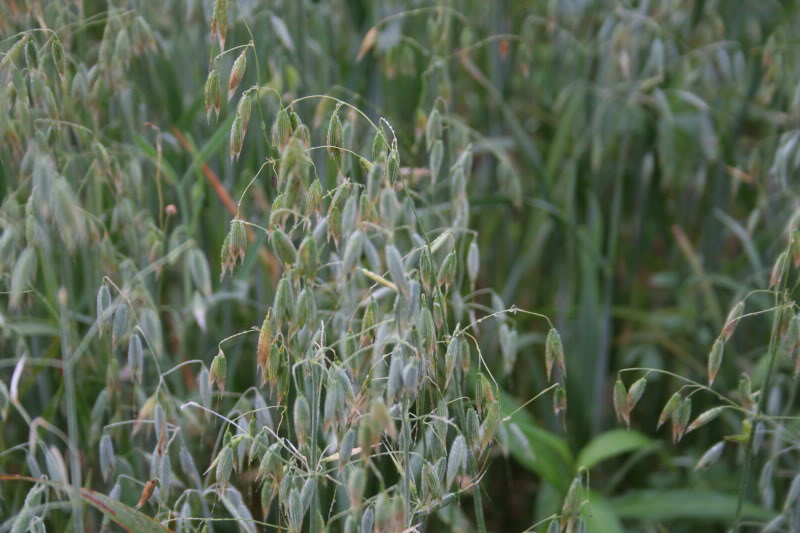
These are just common bin run oats and deer hammered them when they were young and tender and they will do so again this fall. I urge you not to be misled by big ads attempting to convince you to buy "Buck on a Bag" oats because they not only are not better, they are in fact less palatable then more commonly grown oats.
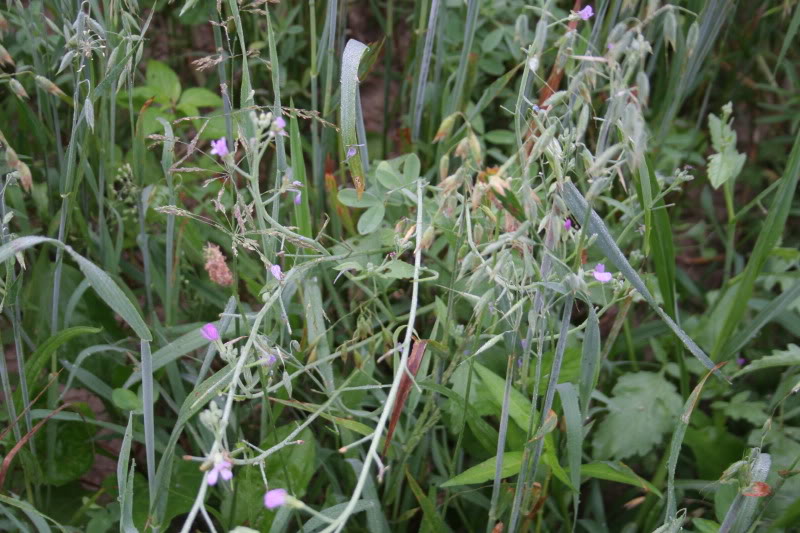
If you decide to purchase certified seed oats, almost any will perform well but I have tested Jerry oats extensively against the highly advertised BFO oats and deer preferred the Jerry oats hands down....save your self some cabbage, avoid the hype and plant common spring oats this fall...combine with winter rye they will make an unbeatable combination... :way:

There is plenty of clover only steps away yet these deer readily dive into the standing rye for the lush clover growing there!

The oats and berseem planted where brassicas had been are maturing now

Instead of leaving a dead barren spot where the dead brassicas had been, I use oats and annual clovers to provide more high quality food sources and build up the soils with a great cover crop. Th chickling vetch added to the mix is a legume like clover and fits in well to add more nitrogen to the soil when I till it under.

The neat thing about this mix is that I will also have free oats when I till it under for the winter rye/oat/forage pea/forage radish/clover mix this fall!

These are just common bin run oats and deer hammered them when they were young and tender and they will do so again this fall. I urge you not to be misled by big ads attempting to convince you to buy "Buck on a Bag" oats because they not only are not better, they are in fact less palatable then more commonly grown oats.

If you decide to purchase certified seed oats, almost any will perform well but I have tested Jerry oats extensively against the highly advertised BFO oats and deer preferred the Jerry oats hands down....save your self some cabbage, avoid the hype and plant common spring oats this fall...combine with winter rye they will make an unbeatable combination... :way:
dbltree
Super Moderator
I'll post this mix periodically as we approach the end of summer/early fall planting time for cereals....
The amounts vary widely because soils, deer densities and budgets also vary, so if you have low deer numbers, poor soils and a tight budget sow the lower rates. If the opposite is true and your budget can handle applying fertilizers to feed the higher planting rates then aim for the higher amounts.
While rye will grow on a brick, every plant in that mix will respond to optimum P&K levels and equally so to up 200#'s of urea per acre, that being said if you can apply any fertilizer at all your cereals will respond in a positive manner. Soil test as if for clover so that P&K and PH can be corrected and then add nitrogen depending on the need. If you have low deer numbers and expect light grazing, pushing growth too early may actually have a negative effect as cereals can quickly grow to a less palatable stage.
A heavy acorn crop for instance could affect usage of any other food sources so consider all the variables before deciding how much if any nitrogen to add. We have high deer densities, combined with the fact that deer have adapted to feeding in specific centralized feeding areas so we push for maximum forage production. Nitrogen will give plants a healthy green color and make them especially attractive to whitetails not to mention insuring greater root production from the radish plants.
This is an example of the above mix fertilized with 400#'s of 6-28-28 and 200#'s of urea...not the beautiful lush green colors of healthy plants!
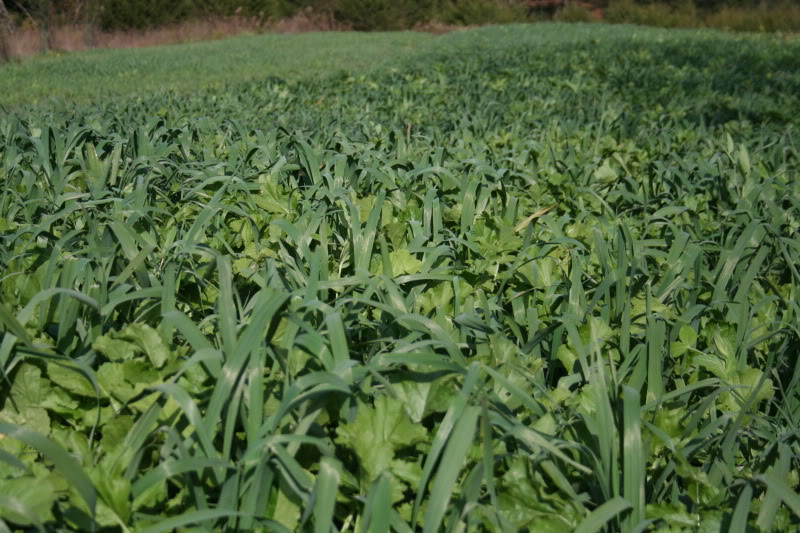
and the stockpiled forage kept them coming literally all winter long!

This pic is an example of a "mini" strip plot where last year the center was brassicas, the foreground was the above mentioned rye mix and the back strip a perennial white clover. I tilled under the dead brassicas and planted oats and berseem that you see here in the center and clipped off the mature rye leaving only the beautiful clover behind.

This coming week I will till under the front strip of clover and plant brassicas and in late August I will mow the oats to shred and scatter the oat seed and then till it under for the above mentioned mix. Even the smallest area then can provide high quality food sources year around! Pick a month...any month...and you will find something here still feeding whitetails. Never is it bare and deer adapt to the fact that they can count on it regardless of the time of year!
This is oats and berseem planted much later, not by choice really but because of wet weather yet we can see that staggering simple plantings like this can be very attractive in keeping deer focused on OUR plot and not the neighbors!

Our goal should always be to attract and hold deer year around and adapt them to coming to one place, down one or two runways so that they not only become predictable, but safely away from our neighbors....
Planting dates can be a week or so earlier in the far north but may be 2-6 weeks later depending on how far south you live.I mix the following:
Winter rye 50-80#'s per acre (56#'s = a bushel)
Spring oats 80-120#'s per acre (32#'s = a bushel)
Austrian Winter Peas 20-80#'s per acre (4010 or 6040 field peas will work fine for 1/2 the price)
Red Clover 8-12#'s per acre, white clover at 6#'s per acre or a mix of 6-8 red and 3-4 white
Groundhog Forage Radish 5#'s per acre
Plant large seeds roughly 1-2" deep, and then cultipack to cover, broadcast clover and radish seed and re-cultipack
Plant fall grains no earlier then the last week of August through mid September , earlier is better when adding peas and clover
The amounts vary widely because soils, deer densities and budgets also vary, so if you have low deer numbers, poor soils and a tight budget sow the lower rates. If the opposite is true and your budget can handle applying fertilizers to feed the higher planting rates then aim for the higher amounts.
While rye will grow on a brick, every plant in that mix will respond to optimum P&K levels and equally so to up 200#'s of urea per acre, that being said if you can apply any fertilizer at all your cereals will respond in a positive manner. Soil test as if for clover so that P&K and PH can be corrected and then add nitrogen depending on the need. If you have low deer numbers and expect light grazing, pushing growth too early may actually have a negative effect as cereals can quickly grow to a less palatable stage.
A heavy acorn crop for instance could affect usage of any other food sources so consider all the variables before deciding how much if any nitrogen to add. We have high deer densities, combined with the fact that deer have adapted to feeding in specific centralized feeding areas so we push for maximum forage production. Nitrogen will give plants a healthy green color and make them especially attractive to whitetails not to mention insuring greater root production from the radish plants.
This is an example of the above mix fertilized with 400#'s of 6-28-28 and 200#'s of urea...not the beautiful lush green colors of healthy plants!

and the stockpiled forage kept them coming literally all winter long!

This pic is an example of a "mini" strip plot where last year the center was brassicas, the foreground was the above mentioned rye mix and the back strip a perennial white clover. I tilled under the dead brassicas and planted oats and berseem that you see here in the center and clipped off the mature rye leaving only the beautiful clover behind.

This coming week I will till under the front strip of clover and plant brassicas and in late August I will mow the oats to shred and scatter the oat seed and then till it under for the above mentioned mix. Even the smallest area then can provide high quality food sources year around! Pick a month...any month...and you will find something here still feeding whitetails. Never is it bare and deer adapt to the fact that they can count on it regardless of the time of year!
This is oats and berseem planted much later, not by choice really but because of wet weather yet we can see that staggering simple plantings like this can be very attractive in keeping deer focused on OUR plot and not the neighbors!

Our goal should always be to attract and hold deer year around and adapt them to coming to one place, down one or two runways so that they not only become predictable, but safely away from our neighbors....
BBD Big Buck Down
Member
When is the earliest you can plant rye and oats for the fall? im going to be planting the brassicas in the next couple weeks. im guessing thats too early for rye and oats?
